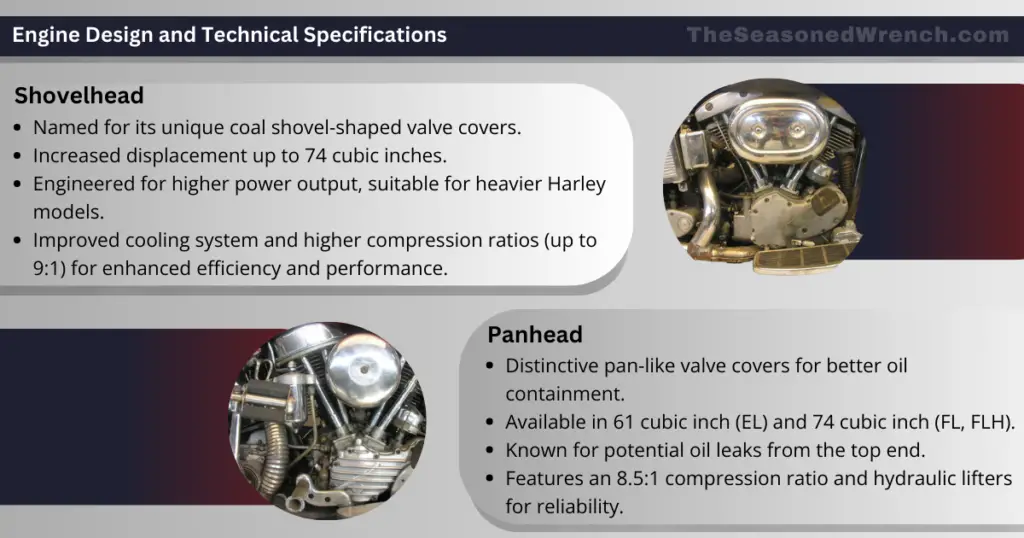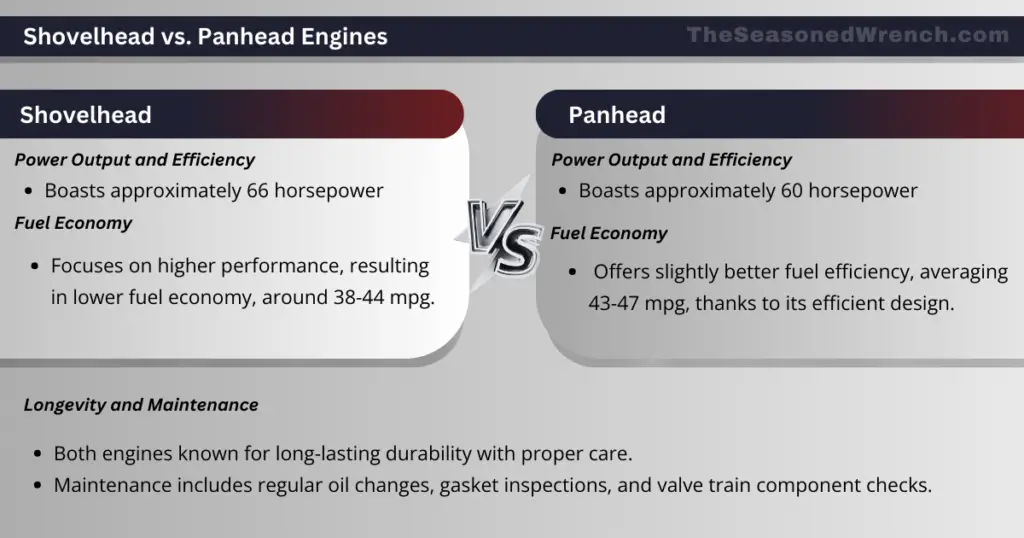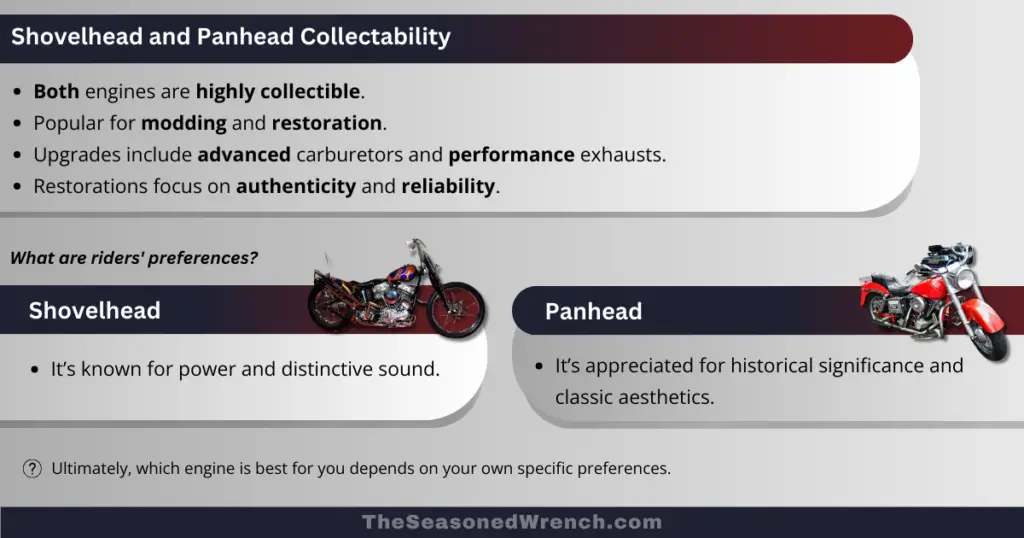
When it comes to iconic motorcycle brands, Harley Davidson stands out with a rich heritage stretching back over a century. Among its many contributions to motorcycle design and engineering, two engine types stand out for their enduring popularity and cultural significance: the Shovelhead and the Panhead.
These engines, named for the distinctive shapes of their valve covers, have left an indelible mark on the motorcycle industry and continue to be sought after by motorcycle enthusiasts today.
This article aims to provide a detailed comparison between the Shovelhead vs Panhead engines, exploring their history, design, performance, aesthetic impact, and continuing influence.
Historical Context
In 1948, Harley Davidson introduced the Panhead engine, a significant upgrade from the previous Knucklehead engine. This new engine was equipped with hydraulic valve lifters and aluminum cylinder heads, enhancing performance while reducing weight.
Eighteen years later, in 1966, the Shovelhead engine was launched, replacing the Panhead. This new engine was tailored to boost power output, catering to Harley’s heavier bikes that now came with electric start and rear suspension.
The shift from Panhead to Shovelhead marked a pivotal moment in Harley Davidson’s engine development, setting the stage for future innovations seen in models like the Evolution and Twin Cam engines.
Now that you know how these two models came to be, let’s dig into how they differ.
Engine Design and Technical Specifications

Panhead Engine
The Panhead engine, introduced in 1948, is recognizable by its distinct shape with pan-like valve covers, designed to enhance oil containment. This engine, available in 61 cubic inch (EL model) and 74 cubic inch (FL, FLH models) displacements, was known for its potential to leak oil from the top end.
Despite concerns around oil leaks, its 8.5:1 compression ratio and hydraulic lifters contribute to a robust and reliable performance, making it a favorite among classic bike enthusiasts.
Shovelhead Engine
Launched in 1966 and produced until 1984, the Shovelhead engine offered increased displacement up to 74 cubic inches and was engineered for higher power output, especially for Harley’s heavier models.
With its improved cooling system and higher compression ratios (up to 9:1), the Harley Davidson Shovelhead engine was a step forward in terms of efficiency and performance.
Read later: Shovelhead Years to Avoid Like The Plague (Here’s Why)
Why Is It Called A Shovelhead?
The Shovelhead got it’s name due to its distinct valve covers shaped like an upside down coal shovel. The unique, coal shovel like appearance of the rocker covers was the key visual characteristic that distinguished them from their predecessors.
Comparative Analysis of Engine Structures
Both the Panhead and Shovelhead are V-twin engines, with two cylinders in a V arrangement. They share overhead valve configurations, with the valves situated in the cylinder head, a design that allows for better air-fuel mixture and efficient combustion.
Despite different external designs, these engines share a lineage in Harley Davidson’s pursuit of combining power with reliability.
Performance, Reliability, and Fuel Economy

Power Output and Efficiency
The Shovelhead engine boasts approximately 66 horsepower, depending on the year, compared to the Panhead’s 60, can be attributed to its advanced design features. Key improvements included a more efficient valve train, larger carburetors, and higher compression ratios, which collectively enhanced combustion efficiency.
Additionally, the Harley Davidson Shovelhead’s redesigned cylinder heads and improved airflow contributed significantly to its higher performance.
Longevity and Maintenance Considerations
Shovelheads and Panheads both are known for their long-lasting durability, often running well for several decades with proper care. Key maintenance practices include regular oil changes, gasket inspections, and checking for wear in the valve train components.
Despite the challenge of finding spare parts due to their age, there’s a robust network of suppliers specializing in vintage Harley Davidson parts, ensuring these engines can be maintained and kept running smoothly for many years.
Fuel Economy
The Panhead engine, may offer slightly better fuel efficiency, averages around 43-47 miles per gallon (mpg), benefiting from its less powerful but more efficient design. As for the Shovelhead Harley, with its focus on higher performance, it generally sees lower fuel economy, averaging around 38-44 mpg.
These figures can vary based on the bike’s overall condition, riding habits, and any custom enhancements made to the engine.
Collectability, Restoration, and Rider Preferences

Collectability and Resale Value
Shovelheads and Panheads both remain highly collectible, often sought after by Harley enthusiasts and vintage motorcycle collectors. Their resale value can significantly vary, typically influenced by factors like the engine’s originality, condition, and historical model year.
Pristine condition Panheads can fetch upwards of $20,000, while well-maintained Shovelheads often range between $10,000 to $15,000. The rarity of certain model years and original factory parts can further escalate their value in the collector’s market.
Mods and Restoration
In the Harley community, modding and restoring both the Shovelhead and Panhead remains a fervent activity. Upgrades often include advanced carburetors like the Mikuni, performance exhausts, and custom visual enhancements. Restorations typically use OEM parts, focusing on authenticity and reliability.
This vibrant culture highlights the engines’ timeless appeal, ensuring their continued performance and presence on roads.
You should also know: what’s the best oil for these Harleys?
Riders’ Experiences and Preferences
Rider preferences between the Panhead and Shovelhead engines show a wide range of opinions across the web. Many Harley Davidson riders are drawn to the Shovelhead for its raw power and distinctive sound, enjoying the engine’s robust performance.
On the other hand, the Panhead is often revered for its historical significance and classic aesthetic, appealing to those who value a more traditional Harley Davidson experience. These differing opinions highlight the unique appeal of each engine type within the Harley community.
Read more: What Year Harleys to Avoid: Comprehensive Guide (Experience)
Recap: And the Winner Is? Let’s Call It a Tie
Shovelheads and Panheads are two of the most iconic motorcycle engines in the history of Harley Davidson, and indeed, in the entire industry. Each offers its unique blend of aesthetics, performance, and cultural significance.
While they may have been replaced by more modern designs, their legacy lives on, and they continue to inspire riders and engineers alike. Whether you’re a fan of the raw power of the Shovelhead or the classic look of the Panhead, there’s no denying the enduring appeal of these remarkable engines.
Read more: Shovelhead vs Panhead vs Knucklehead (Trip Through Time)